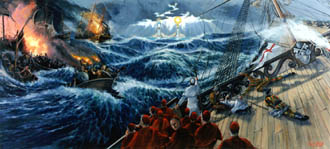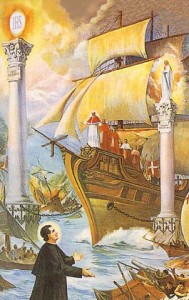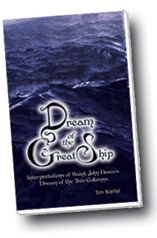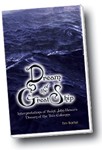In 1862 Saint John Bosco warned about “persecutions that are in store for the Church.” This had been revealed to him in a dream, which he told to four hundred boys. In the dream there was a great ship steered by the pope heading for pillars of the Eucharist and Mary amid storms and hostile enemy ships. John told of these ships ramming the great ship of the Church and of a pope who falls during the battle. The dream caused “no end of wonderment” for the boys and for generations of Catholics. Now for the first time, the meaning of these images is uncovered as author Tim Bartel details the historical events that are unfolding in our lifetime.
This incredible book includes a translation of the dream never before published!
Here are just some of the perplexing images from the dream that you will find explained in this book:
- The exploding book weapons
- The escort ships
- The meeting of captains
- The raging storms
- The pope who falls twice
- The coinciding death and election of popes
- The healing wind
- The two pillars
- The calm waters
You will also learn how the general public knew details of the Third Secret of Fatima during all the years it was safeguarded by popes. Whether you are familiar with John Bosco’s dream of the two columns or you are discovering it for the first time this book will engage you as you encounter the fantastic world of a modern clairvoyant saint and uncover what his dream means to us today.
The Dream

Imagine you are with me on the on a cliff overlooking a vast expanse of sea with no other land in sight except that which is under your feet. In the middle of the endless sea, soaring to the sky, are two solid, stout columns a short distance apart from each other. One is surmounted by a statue of the Blessed Virgin Immaculate, at whose feet hangs a large placard with the inscription: Auxilium Christianorum [Help of Christians]. The other column, far loftier and sturdier, supports a Host of proportionate size, and underneath it is another placard with the inscription: Salus Credentium [Salvation of believers]. From these two columns hang many chains with hooks and anchors in every direction to which ships can be attached.
The water is covered with a countless multitude of battling ships. The prow of each is fitted with beaks of iron that are like spears or arrows stabbing and piercing everything they hit. These ships are heavily armed with cannons, firearms, and incendiary bombs of every kind, even books, and all of them are thronging and chasing after a mighty ship, bigger and taller than any of them. The enemy ships try to ram this stately vessel, to set it on fire, and to damage it in every possible way while an escort fleet shields it. All the efforts of the Pope who captains the great ship are bent to steer it between those two columns against winds and waves that favor the enemy. The commanding general of the flagship, the Roman Pontiff, seeing the enemy’s fury and his auxiliary ships’ grave predicament, summons his captains. All the pilots gather around the captain and hold a conference, but the storm grows steadily more ferocious, and they are sent back to command their own ships lest they founder. When it again grows a little calmer, the captain summons his pilots for a second time as the flagship sticks to its course. The enemy ships keep trying in every way to block, damage and sink the great ship. They bombard it with everything they have: firearms, cannons and incendiary bombs, the beaks of their prows, and with fire from books and journals which they try to hurl into the big ship. The storm becomes dreadful and smashes the ships of the Pope so badly that the enemies let out shouts of victory. The Pope strains every muscle continuing to steer his ship between the two columns as fierce combat ensues and all the enemy ships move in and violently ram his ship again and again. Yet all the efforts of that multitude of ships are useless as their weapons shatter, their guns and cannons sinking into the sea. In a blind fury the enemy forces take to combating the big ship with their hands, fists, books, blasphemies, and curses. Unscathed and undaunted, the flagship keeps on its course.
It is true that at times a formidable ram splinters a gaping hole or wound into the hull of the great ship but immediately, a favorable wind breezes from the two columns and instantly heals the gash and the ship continues on its way. One blow gravely injures the Pope, who suddenly falls down. Those around him immediately help him to get up, but he is struck by a second blow, falls again, and dies. Another shout of victory goes up among the remaining enemies and indescribable rejoicing is seen on their ships. But no sooner is the Pope dead than another takes his place. The assembled pilots elected another captain so quickly that the news of the preceding captain arrives with the news of the election of his successor. The enemy loses courage as the new Pope overcomes every obstacle and routs all the tottering ships with his. Breaking through all resistance, the new Pope steers his ship safely between the two columns. Once in between them, he attaches the prow to an anchor hanging from the column with the Host. With another anchor he attaches the other side of the ship to the column with the Blessed Virgin Immaculate.
Then total disorder breaks out over the whole surface of the sea. All the ships that so far had been battling the Pope’s ship scatter, fleeing and colliding with one another, some foundering and trying to sink the others. Then many of the small ships scurry to the columns and attach themselves to those hooks. Some ships, which had gallantly fought alongside the great ship, are the first to tie up at the two columns. Many others, which had fearfully kept far away from the fight, stand still, cautiously waiting until the wrecked enemy ships vanish under the waves. Then they too head for the two columns, tie up at the swinging hooks, and remain there all safe and secure with the main ship and the Pope.
A great perfect calm now covers the sea.
The Meaning of the Dream

St. Don Bosco’s dream has meaning on more than one level. The basic message is that we should anchor our selves to the Eucharist and Mary for safe harbor. The dream also warns us to stay away from destructive literature and media that promote a culture of death. Although it’s a simple message, the dream describes that staying on course in our Christian pilgrimage requires all our strength.
On a deeper level these things can mean much more. Having the Eucharist as a goal of the pilgrimage can mean that this is a journey to proper Liturgy. The exploding books may represent concepts, ideologies, philosophies and principles that came out of writings of the 1800’s and 1900’s. The enemy forces can be political and military powers from Marxist, Fascist, or Communistic countries. The struggle to maintain course can mean the personal strain of Popes to keep the Church on course after Vatican II.
Beyond that, the dream has a prophetic dimension. Many people can instantly recognize John Paul II as the Pope who falls in the dream and many can see the meeting of captains as the Vatican Councils. The storms are recognizable as various wars but is there any evidence to support these intuitions? Who is the Pope who moors the Church to the Eucharist and Mary and what does the placid water at the end mean? You will find clear and substantiated answers to these questions and many others along with greater details on all these levels of interpretation in this fascinating book Dream of the Great Ship!
What people are saying bout the book:
“interesting speculation in a good detective story looking for clues as to the real meaning of “The Dream”. You have some good insights into the connection between The Dream and Fatima, with some fine comments giving an understanding of the present age and its decadent culture, and of the Church mirroring the Passion, Death, and Resurrection –with a promised “Springtime” coming.
It does appear that the Pope in the Dream is indeed Pope John Paul II with his successor Benedict XVI preparing for the Springtime. You do a good job in refuting the “end times” nonsense with its doomsday apocalyptic scenario. The concept linking the Two Vatican Councils as Amidst the Storm is a fruitful one as well as the explanation of the fury directed against the Church in the 20th c..because of Vatican II’s teaching regarding the world. To paraphrase Page 49- The Church received a violent reaction when the Church in Vatican II reinforced its teaching with a renewed emphasis that the world is the object of its mission of conversion.” ~ Jim Likoudis – author of The Pope, the Council and the Mass
“A good book!” ~ Matthew Arnold – Roman Catholic speaker, author and producer
“The author and his interpretation… are intriguing in their application to his day and even to our own. No one can deny that the events of our day reflect the grave crisis in the church and world of today but also the hope and power of the Eucharist and Mary, the mother of Jesus in the outcome of the war at hand.”
~ Fr. Raymond Skonezzny, STL., SSL
“The author thoughtfully walks the reader through St John Bosco’s dream and applies a systematic interpretation using disciplined approaches. In this journey, the author’s dive into the details doesn’t detract but rather adds to greater understanding of the role of the Church and the battles the Church faces. In addition, the author also provides very interesting comparisons to other dreams of St John Bosco as well as the Fatima secrets, which I found very thought provoking. I also appreciated the footnotes and the thorough references throughout.”
~ T. Black (Foothill Ranch, CA)
“I was really impressed with the depth of information in this book. It explains the dream in ways I never would have imagined.”
– Barnes and Noble Reviewer
© 2006 Tim Bartel


1 thought on “Dream of the Great Ship”